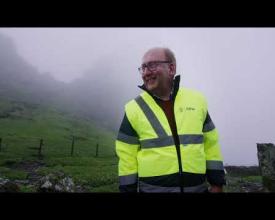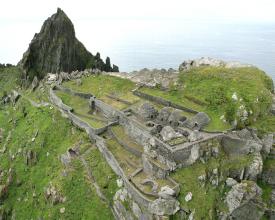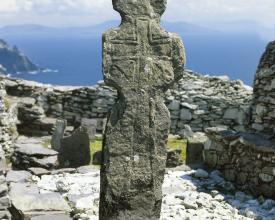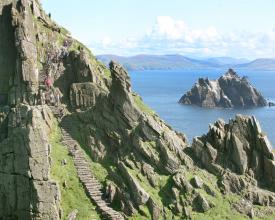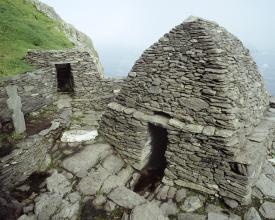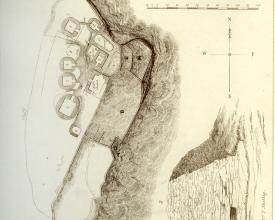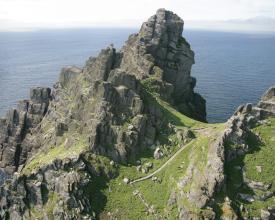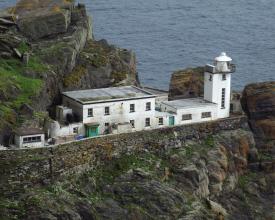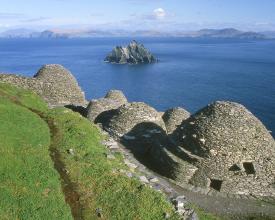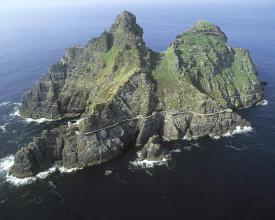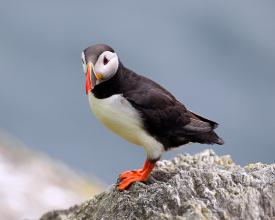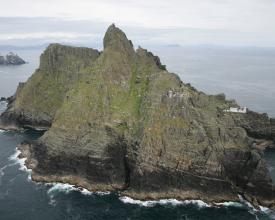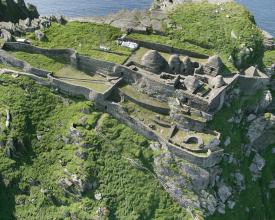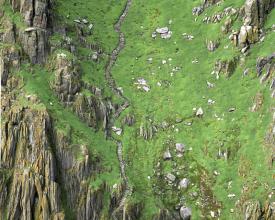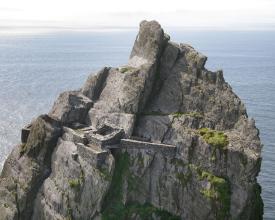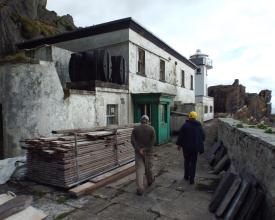
Managing the cultural landscape of Sceilg Mhichíl: connecting nature and culture in a multi-stakeholder management effort
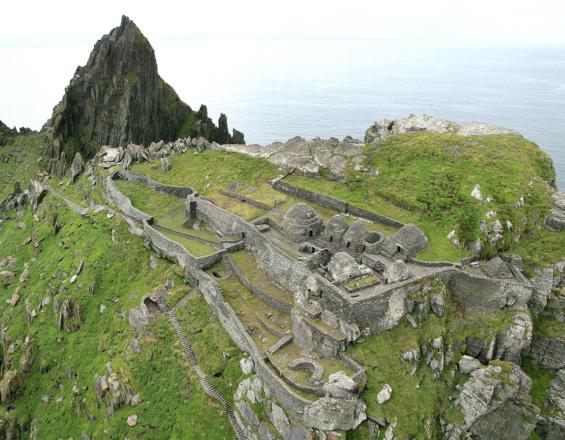
Sceilg Michíl is one of the world’s most spectacular example of early medieval extreme monastic sites located on the Great Skellig, a sandstone island raising 218m above the Atlantic Ocean. The site was inscribed on the World Heritage list in 1996. Additionally, the two Skelligs (Great and Litte Skellig) are also internationally recognised as Key Biodiversity Areas as one of the most important breeding grounds for seabirds.
The management of this place requires an integrated nature-culture approach taking into consideration both the rich natural and cultural values of the place.
The island is managed on the basis of the wider recognition of its multiple values (natural, cultural, social and economic) and access to the island is regulated to ensure the protection and conservation of the place’s natural and cultural values. This is put in place through a system of inter-agency cooperation and constant consultation with local actors and communities living on the Iveragh Peninsula.
Context
Challenges addressed
- Environmental challenges: conservation of fragile breeding grounds, sharing benefits with local actors, climate change vulnerability, conserving nature and culture in an integrated manner
- Social challenges: changes in local communities and local actors, people’s awareness on the Outstanding Universal Value and other values, balancing conservation needs and accessibility
- Economic challenges: local economic development, the Skelligs and the World Heritage property of Skellig Michael plays a key role for the economy of the Iveragh Peninsula through the provision of tourist services and amenities
- Heritage-related challenges: accessibility is limited and weather-dependent, the island has a limited carrying capacity, visitors’ behaviour.
Location
Process
Summary of the process
The pillar of this solution is the recognition of both cultural and natural value (BB1) as a baseline for the management and conservation of Scelig Michíl, as a World Heritage site and a heritage place. The unique features of the site require for management and conservation to be carried out in a nature-culture integrated manner to ensure the conservation of both the archaeological and built remains, and the biodiversity of the island. This important interconnectedness has strengthened the understanding of Scelig Michíl as a cultural landscape (BB2) for which the conservation of the built heritage requires specific attention to the natural features of the place and vice versa. Lastly, the management of a complex landscape requires a network of cooperation with multiple actors at the national (BB2) and local levels, with particular attention to local communities and stakeholder who have the potential of participating in informed decision-making processes. This process is facilitated through the establishment of a Scelig Michíl Stakeholder Forum (BB3), where representatives from all relevant public and private stakeholders group have the chance to meet and exchange with the site management team and the site management institutions.
Building Blocks
Identification and consideration of both natural and cultural values for the management of Sceilg Michíl
Scelig Michíl was inscribed on the World Heritage list for its unique cultural values as a striking early example of remote monasticism. In the management of this site, the significance identified in the OUV is complemented with a deeper understanding of the the interconnected nature-culture significance of the site and management and conservation decisions are met also considering natural, intangible and socio-economic values. In order to fully understand significance of Scelig Michíl as a cultural landscape and as an example of early remote monasticism, there is the need to acknowledge and consider the intrinsic natural values of the place and its role as a striking setting for this monastic archaeological site.
The management plan has committed to further explore the natural heritage of the island, which is internationally recognised and protected as a Special Protection Area and a Nature Reserve, looking at further strengthening the cooperate on between the site management team, the National Parks and Wildlife Service. This includes the preparation of adequate assessment when maintenance and conservation works are planned for the archaeological remains on the island and the inclusion of site-specific conservation objectives and counts for the bird and floral species on the island.
Enabling factors
The management plan 2020-2030 builds on the experience and lessons learned from the previous cycle of management planning (2008-2018) and the long experience and involvement of key stakeholders in the management and conservation of this site.
The building block is further supported by the existing cooperation between cultural and national agencies at the national and local level (from the national ministries to Kerry County Council).
Lesson learned
The conservation of the World Heritage Status and the Special Protected Areas requires a comprehensive understanding of the multi-layered significance of Scelig Michíl as a bird breeding ground, as a biodiversity area and as an archaeological site.
In order to fully understand the significance of Scelig Michíl as a unique example of remote monasticism, one needs to fully understand the spectrum of values that build the significance of the site from both a cultural and natural per perspective. Additionally, the long-terms conservation of the Outstanding Universal Value of is directly dependent with the conservation of the natural environment of Great Skellig and the Skellig SPA.
Managing Scheilg Michíl as an evolved cultural landscape
The landscape setting of Scelig Michíl are vital components for the conservation and protection of the Outstanding Universal Value of the site, for this reason the site of Scelig Michíl is not managed separately as an archaeological site and a natural protected areas but it is managed as an evolved cultural landscape made of cultural and natural values that have been shaped over more than 1300 years of history.
The management of the site requires a careful balancing between natural, cultural and socio-economic values; and the use of the place. The management strategy looks not only at the conservation of the built heritage and the physical fabric of the site but also at the conservation and enhancement of the setting of the place through cooperation among cultural and environmental bodies (institutional, governmental and non-governmental).
The conservation of the cultural attributes of the site requires to consider an overarching set of possible challenges of geological, environmental, cultural but also climatic nature. Additionally, the conservation of the setting of the landscape and the way in which the place is experiences is further enhanced by the limited accessibility to the island, which is required for reasons of security, carrying capacity and for the adequate conservation of bird breeding grounds.
Enabling factors
The management strategy is enabled by the recognition of Scelig Michíl as a cultural landscape created by the interaction between humans and this extraordinary sea- and landscape.
The management plan has been developed and is being implemented through a consensus-based committee led by the Department of Culture, Heritage and the Geltacht (DCHG) and comprising experts from the Office of Public Works (OPW), the National Parks and Wildlife Service (NPWS), the National Monument Service (NMS).
Lesson learned
The work towards the management of Scelig Michíl as a cultural landscape considering both natural and cultural values has been a work in progress that has built on the experience made in the past five decades of management and conservation of the place.
This conservation approach requires a thorough cooperation and coordination among natural and cultural institutional and governmental bodies, the values of the site have to be adequately shared and understood to allow for decision to be taken with the consensus of all relevant stakeholders.
Sceilg Michíl Stakholder Forum
An essential component for the effective management of Scelig Michíl is the establishment of channels for communication and exchange with the multiple local governmental, institutional and private stakeholders based on the Iveragh peninsula, among which there are local communities, public agencies, interest groups dealing with the management of the site, private owners, boatmen, tourism and service industry. The forum is a space in which stakeholders and interest groups can communicate with the site management team and address issues of mutual interest and to inform decision-making processes. Additionally, the forum offers a space to promote public awareness and pursue the engagement of the local stakeholders with the World Heritage property of Scelig Michíl.
The forum is organized and coordinated by the OPW in cooperation with Skellig Michael Implementation Group and it includes representatives of all relevant interes groups.
This approach is fundamental also in view of strengthening existing cooperation with national and local partners in the development of a sustainable tourism strategy for the site, a project that has already begun in 2017 with the comprehensive Visitor Experience Development Plan that was published as a result of the cooperation between OPW, Failté Ireland and local stakeholders.
Enabling factors
The creation of a forum has been enabled through the experience of close cooperation carried out by Office of Public Works (OPW) which in the management of the site and the cooperation with local community . This cooperation has been long harnessed through the constant and long-term presence of the management team on site and the active involvement with local communities, including both public and private bodies.
Lesson learned
Communities and local actors have a fundamental role in the effective management of Scelig Michíl. The forum itself is the result of the lessons learned during the implementation of the 2008-2018 World Heritage Management plan and the overall conservation and management of the island in the past four decades.
The effective management of a heritage place and particularly of a World Heritage properties requires the establishment of an adequate structure of communication and consultation with local communities, key public and private stakeholders to ensure that decisions are taken with in an informed manner and after adequate consultation.
The implementation of the previous plan has underlined the importance of holding regular meetings with communities, local authorities, local interests groups to discuss specific areas of interest, and the forum offers a change to bring together all relevant stakeholders for more comprehensive discussions on the conservation of the site as well as its sustainable use.
Impacts
Sceilg Michíl is one of the most impressive early-monastic settlements in the world. It location on the remote rocky island of the Great Skellig makes this place even more significant. The management of Skellig Michael requires the comprehensive understanding of the site’s unique cultural and natural value as a cultural landscape, its natural conformation as a lonely rocky island well represent the ideas behind extreme monasticism and the archaeological complex of Sceilg Michíl. The integrated management strategy for the site looks at strengthening the nature-culture connections as baseline for the management and conservation of the site
The management in place, through constant processes of consultation and discussion with local communities and stakeholders as the place represents a change for local development and sustains the livelihoods of many living on the Iveragh peninsula.
Beneficiaries
The main beneficiary is the site as the integrated management allows for a more comprehensive understanding and management of the place. Local actors are also beneficiaries though the systems of enhanced participation and consultation.
